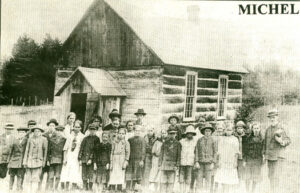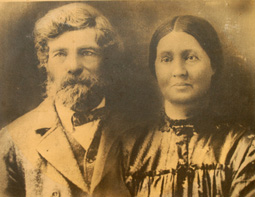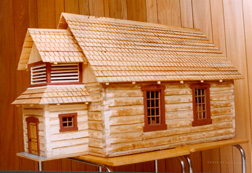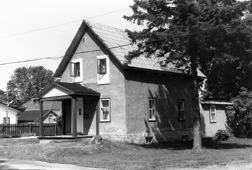
The First St. John’s Church, built in 1975, as seen circa 1915
Gustav Michel was born in 1834, in Tuppendorf, Kreis Gurau, Silesia, and was a stone mason by trade. He and his wife Caroline (nee Fritsch) had arrived in Canada in early 1867 by ship, unfortunately losing their three children, one son and two daughters, during the voyage. Having spent their first summer living in a field, and their first winter boarding with the family of William Gutzman (a tailor from Gemany), the Michels, by 1871, had built themselves their home. The house still stands today, directly across from the present location of the church. The Michel home was the scene of religious services prior to the building of the first church in 1875.
While the congregation was founded in 1867, it was more of a loose gathering of people of the same faith, rather than a formal grouping belonging to a Synod. A resident Pastor, both then and for some time to come, was not practical: the congregation was simply too small to support one. In April of 1873, during a four-week visit, Pastor Friedrick Ehinger took steps to organize it along more formal lines. Pastor Ehinger called “all heads of the households, and male members of age” to gather at the home of Paul Dannhauer on May 7, 1873. At this meeting, several steps were taken to establish the congregation: officers and trustees were elected, minutes were kept, and a constitution was read, discussed and adopted. The newly-formed council was to send a letter to the President of the Evangelical Lutheran Synod of Canada, requesting permission to join.
In a book presented to the congregation a few days later, on May 10, 1873, Pastor Ehinger promised the sum of ten dollars toward the construction of “a sanctuary,” or church. Interestingly, in order to qualify for the funds, the members had to accept the good Pastor as a member of their congregation “in this far corner of civilization.”

Paul and Caroline Dannhauer, donors of the land for the first St. John’s church
The congregation still lacked that most obvious of indicators: a purpose-built church. On December 26, 1874, it was decided that the time had come to build the congregation’s first church. On land donated by Paul and Caroline Dannhauer, work started in March of 1875 and was supervised by Gustav Michel. The cornerstone was laid by Pastor Graepp on September 23, 1875, following the morning service. The original document describing the laying of the cornerstone states in part, “The church shall bear the name ‘St. John’s Church.’” This is the first recorded use of the formal name of the church.

A model of the first St. John’s church, built in 1875
Even then the church was not totally complete, as a bell was needed to complete the building. It was not until 1883 that a suitable bell was located, a two hundred pound instrument tuned to the key of F, 21 inches in diameter, and purchased at a cost of $54.00 from the Buckeye Bell Foundry, Vanduzen and Tift, Cincinnati, Ohio, USA. The bell was delivered to the home of Gustav Michel, where it was stored in the hayloft while the wooden hangar for it was completed. In this, we can see a lighter side to the lives of our ancestors. Apparently, Gustav Michel made the hangar (or caused it to be made) and, one Sunday morning, he informed his sons that the hangar was completed. No staid, formal lifting of the bell to its proper place for him, though: with the contrivance of his sons, they hurried the bell and its hangar over to the little wooden church early in the morning, and surprised their fellow members by ringing it once or twice to call members to worship.

The Stashik Home as it Appeared in the 1990’s
In 1897, due to the construction of a second and larger church, the original log church was moved from its initial position (west of the current church) to the area now occupied by Luther Hall. It was subsequently used as a German catechetical school for the children into the 1920’s. On June 1, 1925. a special meeting was convened at which Pastor Grunwald announced the canvassing for a new parish hall. it was decided that the old school should be sold, and that the proceeds be put towards the cost of the new hall. In the event, Mr. Andrew (Andy) Stashick bought the building for the sum of $100.00, and had it moved to Pembroke in the fall of that year. Once in place and fully completed the Stashicks, who had been married in 1923, took up residence. They remained there constantly. In 1966, Mrs. Stashick said of the one-time church and school, “We experienced much happiness in this warm home.”